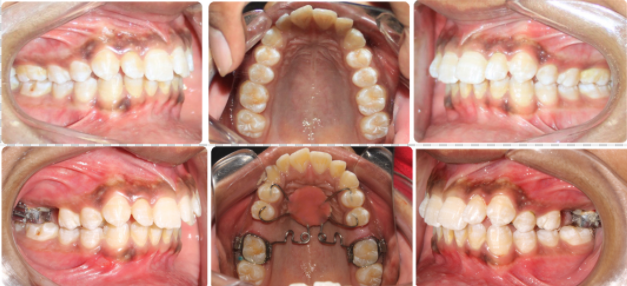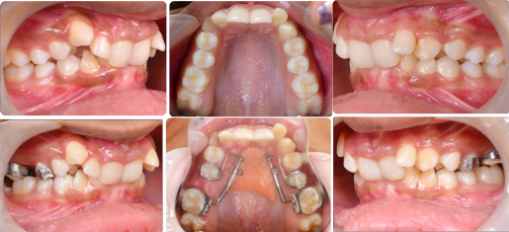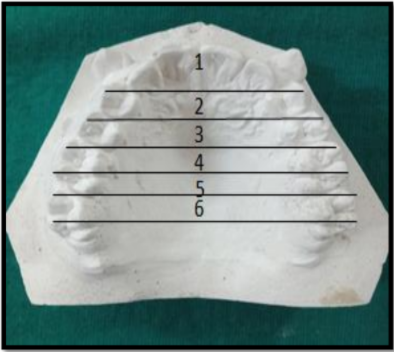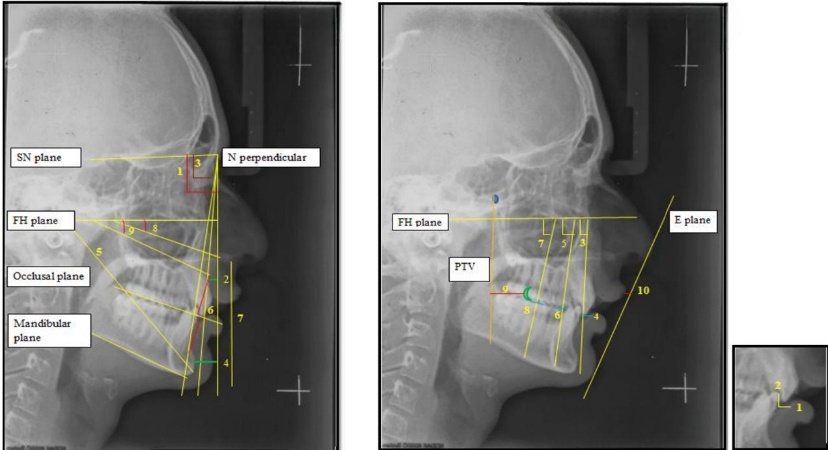Introduction
Correction of Angle’s Class II malocclusion is one of the commonest, yet challenging problem confronting the orthodontic profession.1 Extraction of teeth has always been a matter of discussion while doing orthodontic treatment planning. As per the literature, the debate of non-extraction or extraction concept for orthodontic treatment has kept swinging from the Angle era that favoured maintenance of the natural dentition to Charles Tweed & Raymond Beggs who advocated the need for orthodontic extractions.2 The current orthodontic philosophies have been oriented towards conservative treatment modalities to avoid extractions and at the same time try to eliminate the need for patient cooperation.3 There are various methods of gaining space which include proximal stripping, arch expansion, extraction, uprighting, derotation of posterior and molar distalization. One of the non-compliant therapies with non-extraction approach is Molar distalization that has added a new column in the practice of every orthodontist to produce consistent, predictable and high-quality results. Many class II malocclusions can be benefited by getting them treated through molar distalisation and prevent unnecessary extractions.4 We can gain space by moving the molars distally in either of the maxillary or the mandibular arch. The distalization of maxillary molar is more predictable as compared to mandibular ones because of cancellous bone in the maxilla and a more compact bony structure in the mandible. Maxillary molar distalization can be carried out in patients who have a dental Class II malocclusion on a skeletal Class I base with mild to moderate dental crowding. It is preferably carried out in the mixed dentition period where there is premature exfoliation of primary maxillary second molars leading to mesial migration of the permanent maxillary first molars prior to eruption of permanent maxillary second molars. In non-growing patients, it can be used to regain the lost arch length leading to blocked out canines and premolars. This procedure is not used for those patients who exhibit severe dental crowding or dentoalveolar protrusion or associated skeletal discrepancy as a result of retrognathic mandible. Distalising appliances can be extra-oral headgears, intraoral, either fixed or removable. 5, 6, 7, 8 The problems related to patient’s compliance have led clinicians to prefer fixed intra-oral distalizing system that minimizes reliance on the patient’s co-operation and are under control of the orthodontist. So, the Pendulum appliance developed by Hilgers in 1992 and the Distal jet appliance developed by Carano and Testa in 1996 are two of the more commonly used “non-compliance appliances” for molar distalization. 9 Although Molar distalization is targeted to produce sagittal changes, some amount of transverse and vertical changes also accompanies molar distalization. Therefore, keeping this in mind, this study was designed as an attempt to compare the clinical efficiency of pendulum and distal jet appliance using both cephalometric parameters as well as dental cast analysis so as to evaluate the effect of these appliances in all three planes of space. Therefore, this study aimed to compare the clinical outcomes of two intra-oral distalizing appliances namely Pendulum and the Distal Jet appliance.
Materials and Methods
This in vivo prospective study was performed over 10 patients for maxillary molar distalization at AMC Dental College, Ahmedabad. The study was approved by Institutional Ethical Committee to conduct an in-vivo prospective study with certificate number-XXX/IEC/ORTHO/XX50/19. The inclusion criteria were the patients either of the gender having Angle’s Class II malocclusion with mild to moderate crowding /discrepancy in upper arch with pleasant profile, all set of permeant teeth should be present. Patients with cranio-facial malformations, TMJ disorders, history of trauma or underlying systemic diseased, poor periodontal health were excluded.
The sample size initially decided for carrying out this study was 20 based on the sample size calculation where the power of the study kept as 95% which had to be reduced to 10 because of disruption of the clinical practice during the lockdown due to Covid-19 pandemic. Therefore, 10 patients who reported to the Department meeting the inclusion criteria were enrolled in the study a written assent /consent obtained from the parent and patient and then were randomized to receive treatment with either pendulum or the distal jet appliance.
Randomization method
In order to reduce susceptibility bias and ensure that equal number of patients were allocated to each of the treatment groups, the patients were randomly assigned to both the treatment modalities. Keeping in mind the inclusion criteria, the subjects received pendulum appliance and distal jet appliance alternatively in sequence of their reporting to the Department of Orthodontics.
Hence out of 10 subjects, two groups were made where randomly, 5 patients received pendulum appliances and other 5 received distal jet appliances for intra oral molar distalization. During the period of molar distalization, no other appliances were placed. Fixed appliances were placed in the second phase which was not a part of this study.
Figure 1 shows the intra-oral image before and after distalization using the pendulum appliance. The pendulum springs were made from 0.032-inch TMA wire. The lingual sheath of the molar band having a diameter 0.036 inch was used. The upper first premolars were bonded with a retentive arm made of 21-gauge stainless steel wire. Each wire component was incorporated into the acrylic button.
Insertion and activation
The springs were inserted into the lingual sheaths using finger pressure and a Weingart plier. This 60° activation exerted approximately 230 g of distalizing force. Reactivation was done every 4 weeks if required by pushing the spring distally and re-inserting it. 9
Figure 2 shows the intra-oral image before and after distalization using the distal jet appliance. It comes with various components that are assembled to install the appliance. It has lingual sheaths, transpalatal connector, Bayonet, directors and the nance button. Firstly, the transpalatal connector was formed and waxed in place. It was soldered, polished and repositioned on model. Separating medium was painted on palate. Next the bayonets were bent and inserted in sheaths. They were adjusted and cut to length as necessary. Then the directors were placed on bayonets, wire section was bent, adjust and cut to length. All cut ends of the bayonets and directors were kept smooth and with free sliding movement without causing any friction. Following this, the nance acrylic button was made using Salt and pepper method and it was trimmed and polished. Then stops, springs and locks were added and the screws were tightened lightly. Springs were not compressed.
Appliance placement and activation
The appliance was seated completely for checking the fit prior cementation. The passive fit of directors and bayonets was checked and adjusted as necessary. The appliance was activated initially after cementation and at four-week intervals by complete compression of coil spring with the activation lock. The forces generated by the Ni-Ti coils were recommended by Patricia Chiu and James A. McNamara 9 (240 g).
Appliance removal
Once class I molar relation was achieved; both the appliances were removed and a nance palatal button was delivered to hold the molars in its position.
All diagnostic records for all patients in both groups were taken at two observation time points:
T1: Pre - Distalization
T2: Post - Distalization (after achievement of Class I relationship)
T3: Difference between T1 and T2 for individual groups
The outcome of results in the pendulum group was compared to that of distal jet appliance at two-time intervals i.e. pre - distalization and post - distalization using;
Cephalometric measurements (Figure 3)
All cephalometric radiographs were taken with KODAK 8000 Cephalostat machine (78 kv, 8 ma & exposure time of 0.2 s), (Carestream Health Inc. NY, USA). Lateral cephalograms for each patient at T1 (pre-distalization) and T2 (post- distalization), in both treatment groups were standardized. Lateral cephalograms of a given series were hand traced at a single sitting in the same manner by one investigator. To reduce the chances of error, the cephalograms were traced twice by the same investigator after one week interval. The cephalometric analysis, consisted of 20 variables shown in Table 1 (Skeletal, Dental and Soft tissue Cephalometric Measurements) for Each tracing. (“Insert Table 1)
Dental cast analysis (Figure 4)
The dental cast analysis performed according to the technique of Ghosh and Nanda 10 to determine any maxillary transverse or molar rotational changes following molar distalization. Transverse measurements were recorded between the buccal cusp tips of the maxillary first and second premolars along with the mesio-buccal and distobuccal cusp tips of the maxillary first and second molars.
The data on Continuous variable is presented as mean ± standard deviation (SD). Normality assumption was tested using the Shapiro-Wilk test. The significance of mean at pre - distalization and post - distalization was done by paired t-test/ Wilcoxon Signed Rank test and the significance of mean difference between two groups was done by unpaired t-test/ Mann Whitney test. The entire data was statistically analyzed using Statistical Package for Social Sciences (SPSS version 20.0, IBM Corporation, USA) for MS Windows. P<0.05*, P<0.01** and P<0.001***.
Results
A total of 10 patients were given pendulum or distal jet appliance alternatively as an attempt to compare their clinical efficiency. The appliances were kept in place till a “Class I” molar relationship was achieved. Lateral cephalograms and models were taken at two-time intervals T1 (pre – distalization) and T2 (post - distalization) and results were tabulated for comparison.
Table 1
Skeletal & dental and soft tissue parameters for cephalometric analysis
Table 2
Comparison of Pre -distalization and Post - distalization Skeletal, Dental & Soft tissue cephalometric measurements for PENDULUM APPLIANCE (Paired t-test)
Table 3
Comparison of Pre - distalization and Post - distalization Skeletal, Dental & Soft tissue cephalometric measurements for Distal Jet Appliance (Paired t-test)
Table 4
Comparison of Skeletal, Dental & Soft tissue Cephalometric measurements inPendulum Appliance V/S Distal Jet Appliance (Unpaired t test)
Table 5
Comparison of transverse dental measurements using dental cast analysis in Pendulum Appliance V/S Distal Jet Appliance (Unpaired t-test)
Table 6
Comparison of mean time taken fordistalization in months between pendulum appliance & distal jet appliance (Unpaired t-test)
|
Pendulum |
Distal jet |
P value |
||
|
Mean |
SD |
Mean |
SD |
|
|
4.68 |
0.67 |
5.84 |
0.70 |
<0.05* |
Figure 1
Pre-distalization and post-distalization intraoral photographs using the Pendulum appliance.

Figure 2
Pre-distalization and post-distalization intraoral photographs using the Distal jet appliance.

Figure 4
Measurements for dental cast analysis. 1-Distance between buccal cusp tips of upper first premolars. 2-Distance between buccal cusp tips of upper second premolars. 3-Distance between buccal cusp tips of mesio-buccal cusps of upper first molars. 4-Distance between buccal cusp tips of disto-buccal cusps of upper first molars. 5-Distance between buccal cusp tips of mesio-buccal cusps of upper second molars. 6-Distance between buccal cusp tips of disto-buccal cusps of upper second molars.

Table 2 shows comparison of Pre -distalization and Post - distalization Skeletal, Dental & Soft tissue cephalometric measurements for PENDULUM APPLIANCE (Paired t-test). The skeletal changes with using a pendulum appliance were increase in lower anterior facial height from T1 to T2. The dental parameters show that the over jet increased post distalization and the overbite decreased. 6.8 degrees of proclination was observed. The upper incisor to FH plane linear measurement showed a significant decrease which suggest relative intrusion of upper anteriors due to proclination. The upper first molars parameters were decrease in the upper 6 to FH angular and PTV-6 which shows distal tipping and distalization of 4.4 mm with increase in the linear measurement showing extrusion. The upper lip to E line linear measurement decreased as a result of the protrusion of the upper lip due to proclination.
Table 3 shows comparison of Pre -distalization and Post - distalization Skeletal, Dental & Soft tissue cephalometric measurements for DISTAL JET APPLIANCE (Paired t-test). The lower anterior facial height and the mandibular plane FH-MP increased by 1.2mm and 1.2 degrees respectively from T1 to T2. The increase in Co-Gn which was suggestive of increase in mandibular length post distalization. The dental changes using a distal jet shows the increase in overjet by 0.8 mm and overbite reduction by 1 mm, U1 to FH angular had increased by 3.2 degrees and The U1 vertical had decreased by 1.2 mm which was statistically significant. U4 to FH angular had increased by 1.8 degrees and U4 vertical had increased by 1.20 mm suggestive of mesial tipping and extrusion of maxillary first premolars. 3.8 mm of distal movement of the molars was observed which can be confirmed with the decrease in the linear measurement PTV-6. U6 vertical increased by 1.2 mm suggesting extrusion of the upper first molar with distalization and the UL to E plane had increased by 0.20 mm which was not statistically significant.
Table 4 shows comparison of Skeletal, Dental & Soft tissue Cephalometric measurements inPendulum Appliance V/S Distal Jet Appliance (Unpaired t test). The mean difference in T3 calculated using unpaired t-test shows that the SNA, ANB and Pg-N perpendicular were slight increase in pendulum as compared to distal jet which was not statistically significant. Co-Gn, ANS-Me, FH-MP had increased more in pendulum as compared to distal jet which was not significant. FH-MP had increased more in pendulum as compared to distal jet which was not significant. Overjet, U1 to FH angular, U4 to FH angular, U4 vertical, U6 vertical were more increased in pendulum group as compared to distal jet group. The parameters overbite (0.20 mm), U1 vertical (1mm), U6 to FH angular (5 degrees), U6-PTV is suggestive of more amount of distalization in pendulum by 0.6 mm. The protrusion of upper lip (UL to E) was increased more in pendulum group.
Table 5 shows comparison of transverse dental measurements using dental cast analysis in PENDULUM APPLIANCE v/s DISTAL JET APPLIANCE (Unpaired t-test). The difference in the expansion observed at level of maxillary first premolar (1mm),mesio-buccal cusp tip of maxillary first molar (2.2mm), distobuccal cusp tip of maxillary first molar (2.8 mm), mesio-buccal cusp of second molar (1.4 mm) and distobuccal cusp of second molar (1mm) was more in distal jet as compare to pendulum.
The Table 6 shows the mean duration of distalization in pendulum group was 4.68 months and distal jet group was 5.84 months respectively.
Discussion
One of the major difficulties in treating patients with a Class II molar relationship is the need for distalization into a Class I relationship. Several methods have been used in molar distalization including headgears, Class II elastics, and removable appliances. The search for an appliance that would require minimum patient compliance has moved from the use of the pendulum appliance and the distal jet appliance. 10 The following in vivo prospective study’s evaluation used sample of 10 patients (5 in each group). The results of this study show that the both the appliances primarily affect the dentition, although there were simultaneous indirect effects on the skeletal and soft tissue structures.
Skeletal, dental and soft tissue changes observed post distalization using pendulum appliance
The Table 2 depicts the changes with the pendulum appliance where on the skeletal parameters, it was observed that the form T1 to T2, the lower facial height increased due to extrusion of molars with distalization which can be seen in the values U6 to vertical indicating the change in point B and lower anterior facial height which has increased. These findings are in accordance with data obtained by and Patrica P. Chiu et al. 9 the findings were contrasting with the study conducted by Timothy J. Bussick et al. 11 because they used pendulum in mixed dentition taking support from deciduous second molar. There was increase in the overjet and reduction in overbite post distalization due to proclination and relative intrusion of the upper anteriors causing protrusion of the upper lip as a reciprocal effect of the pendulum on the anterior teeth. Similar results were also reported by Patrica P. Chiu et al 9 and Joydeep Ghosh et al.10 There was distal movement and distal tipping along with extrusion of the molars with the pendulum appliance was observed.
Skeletal, dental and soft tissue changes observed post distalization using distal jet appliance
The Table 3 depicts the changes with the distal jet appliance from T1 to T2. The lower anterior facial height and the mandibular plane FH-MP increased subsequently due to opening of the mandibular plane and forward movement of B point with molar distalization thus increasing the lower anterior facial height which in turn increasing the mandibular body length. Similar results were observed by Rachelle et al. 12 and Patrica and James McNamara et al. 9 There was increase in overjet and reduction in the overbite with distalization was observed due to reciprocal counteracting action on the anterior teeth. These results are in accordance with the study conducted by Pravinkumar S Marure et al. 13 Significant distal movement of molars was observed with the distal jet appliance. The distal tipping of molars has occurred but was not statistically significant due to the unique design of the distal jet where force through a mechanical couple closer to the center of resistance of the tooth. Some amount of extrusion of the molar was also observed with its distal movement.
Pendulum v/s distal jet (cephalometric)
Table 4 shows the mean difference in T3 calculated using unpaired t-test showed that the mean of SNA, SNB, ANB and Pg to N –perpendicular had remained relatively same in both appliances which confirms that there is minimal change in point A with distalization of the molars by using any of the above-mentioned appliance. Similar results were observed by Alberto Caprioglio et al. 14 Lower anterior facial height increased in both the groups attributing to extrusion of molars with distalization. FH-MP values also increased due to the same reason. The mandibular body length increased more in distal jet group as compared to pendulum group which was not significant because the changes in B point was observed more with the distal jet group as compared to pendulum group. 2 The Pt A to N –perp was slightly increased in distal jet in the present study by 0.2mm which is contrasting with the study performed by Patrica and James McNamara et al. 9 because they used the distalizing appliance concurrent with the full fixed appliance.
The observed dental changes amongst both the groups like Overjet, U1 to FH angular, U4 to FH angular, U4 vertical, U6 vertical were more increased in pendulum group as compared to distal jet group. This might have occurred because the pendulum appliance causes more reciprocal force generation on the anterior segment. These results are in accordance with Alberto Caprioglio et al. 14 More amount of distalization was observed in pendulum group (0.6 mm) as compared to distal jet group. On the other hand, less distal tipping of the molars was observed with the distal jet. This signifies that a more bodily movement of the molars occur with the distal jet appliance due to its unique design causing the force to pass near the center of resistance.
The soft tissue parameter UL to E (protrusion of upper lip) in the present study was increased more in pendulum group basically due to increased proclination of upper incisors as compared to distal jet group by 0.8 mm which is in accordance with Ashok Karad et al 15 and Ferguson Dj et al. 16
Pendulum v/s distal jet (dental cast analysis)
Table 5 shows the transverse changes with both of thedistalizing appliance. It was observed that the expansion at level of first and second premolar as well as first and second molar happened in both the groups. The expansion at the premolar region was more with distal jet as compared to pendulum because the premolar may have drifted mesially with distalization. There was minimal increase in intermolar width between the mesio-buccal cusp tips (1.2 mm) and more at the distobuccal cusp tips (0.60 mm) at the level of maxillary first molar. This is suggestive of mesio-buccal rotation which is favorable for achievement of Class I molar relationship with the pendulum group. These findings were in accordance with study done by Joydeep Ghosh et al. 10 The more expansion seen in the distal jet group could be attributed to its design. The distal jet is fabricated with a telescopic unit positioned parallel to a line passing through the contact points of posterior teeth. With this geometry, distalization produces divergence of right and left molars along the natural shape of the dental arch form. The overall results of transverse dental measurements using dental cast analysis showed that there was expansion at all levels in both groups with more expansion at the level of first premolar, first and second molar in the distal jet group as compared to pendulum group along with mesio-buccal rotation of first molar in pendulum group and mesio-buccal rotation of second molar in distal jet group. 17
Comparing the total time required for distalisation while using both the appliances
Table 6 depicts the total time required for distalizing the molars with both the appliances. This showed that mean time taken for distalization was lesser in the pendulum group as compared to distal jet group which was statistically significant in accordance with Patrica and James McNamara et al. 9
Conclusion
An attempt was made to compare the clinical efficiency between Pendulum and Distal jet appliances (in terms of amount of molar distalization and time taken for distalization). The conclusion derived from the present study is enlisted as follows:
The pendulum appliance showed a significant increase in lower anterior facial height (ANS-Me) along with increase in SNB.11
The pendulum group exhibited significant increase in U1-FH angular, Overjet and UL-E measurements. Intrusion of the upper anteriors causing overbite reduction, mesial tipping and extrusion of maxillary first premolars, distal tipping and extrusion of maxillary first molars along with its distalization.9
The distal jet appliance showed a significant increase in mandibular length, lower anterior facial height and opening of mandibular plane angle. It also showed flaring of upper anteriors with increase in overjet. Intrusion of upper anteriors causing overbite reduction. Mesial tipping and extrusion of maxillary first premolars, distal tipping and extrusion of maxillary first molars along with their distalization.9
Relative intrusion of upper incisors was found to be more in pendulum group as compared to distal jet group. 10
The mean time taken for molar distalization was significantly lesser in pendulum group as compared to distal jet group.9
The transverse expansion at the level of first molars was significantly more in distal jet group as compared to pendulum group.17
Thus, Pendulum and distal jet appliances were found to be equally effective clinically in distalizing the maxillary molars, although the distalization period was shorter in pendulum group as compared to distal jet group owing to more distal tipping of maxillary first molars in pendulum group. The transverse expansion was seen in both appliances which can help to maintain a proper transverse relationship of maxillary and mandibular molars during distalization and aid in Class II correction. The expansion was significantly more in distal jet group compared to the pendulum group which could be beneficial for patients who have Class II malocclusion with mild posterior crossbite. Had it not been for Covid-19 pandemic, more subjects could have been included to validate the findings. Consideration of long-term follow–up could have aided in a better appreciation of the effects produced by the two appliances.

